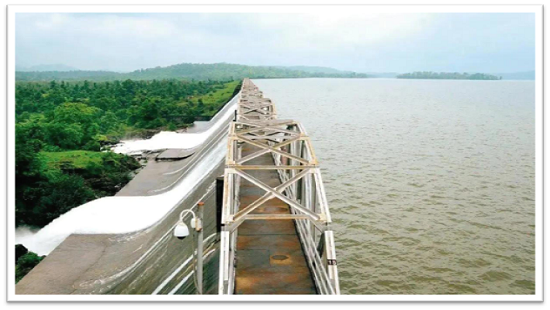
Mumbai’s Seven Reservoirs Brimming at 97.68% Capacity: A Promising Outlook for the City’s Water Security
Mumbai’s water supply system has received a major boost as the seven reservoirs that provide drinking water to the city have reached an impressive 97.68 percent of their total capacity. According to the Brihanmumbai Municipal Corporation (BMC), the collective water stock as of October 14 stands at 14,13,808 million litres — a level that ensures a comfortable water reserve for the coming months.
This development comes as welcome news for Mumbaikars, particularly after the monsoon’s gradual withdrawal. The high reservoir levels not only guarantee steady water availability but also reflect efficient resource management and consistent rainfall during the season.
Strong Water Levels Across Major Lakes
Mumbai’s water supply is drawn from seven key reservoirs: Upper Vaitarna, Modak Sagar, Tansa, Middle Vaitarna, Bhatsa, Vehar, and Tulsi. Together, they form the lifeline of the city, catering to the daily water needs of more than 1.84 crore residents.
As of the latest data, Upper Vaitarna and Vehar are at full capacity (100%), followed closely by Middle Vaitarna at 99.84%, Bhatsa at 97.82%, Tulsi at 97.71%, Tansa at 96.50%, and Modak Sagar at 90.43%. These figures indicate a healthy water storage position, providing the civic body with a strong buffer to manage supply efficiently throughout the post-monsoon and dry seasons.
The western suburbs — from Dahisar Check Naka to Bandra, and areas stretching up to Malabar Hill — receive their water from Lower (Modak Sagar), Middle, and Upper Vaitarna lakes along with Tansa. Meanwhile, the eastern suburbs from Mulund to Sion and Mazgaon are primarily serviced by the Bhatsa, Vehar, and Tulsi system, with water treated at the Panjarpur Water Treatment Plant before distribution.
Stable Supply, Reduced Risk of Water Cuts
The near-capacity reservoir levels significantly reduce the likelihood of water cuts in Mumbai, a recurring concern in years with inconsistent rainfall. Historically, the BMC implements a 10–15% water supply cut when reservoir levels fall below the annual safety threshold, particularly during summer months.
With storage levels now near full, the BMC is well-positioned to maintain an uninterrupted water supply across all administrative wards. Officials have confirmed that the current stock is sufficient to meet the city’s needs until the onset of the next monsoon season, even accounting for daily usage and evaporation losses.
A Season of Balance: Weather Update from IMD
While Mumbai’s water bodies remain replenished, the city itself has transitioned into a hot and humid post-monsoon phase. On Tuesday, residents experienced dry conditions under clear skies, with no rainfall recorded across either of the India Meteorological Department’s (IMD) observatories.
At Colaba, temperatures peaked at 32.2°C — about 1°C above normal — with humidity hovering around 78%. Santacruz recorded a slightly higher maximum of 34.4°C and a minimum of 21.6°C, with relative humidity at 69%. The IMD forecast predicts clear skies in the morning and partly cloudy conditions by evening, consistent with typical October weather as Mumbai transitions from monsoon to winter.
Building Resilience Through Smart Water Management
The robust water stock highlights not just favourable monsoon conditions but also the BMC’s ongoing efforts in water conservation and efficient resource allocation. Over the past few years, Mumbai has strengthened its integrated water management systems, including real-time monitoring of lake levels, preventive maintenance of pipelines, and improved leak detection infrastructure.
Additionally, the civic body continues to promote rainwater harvesting, recycling of wastewater, and public awareness campaigns to encourage judicious water use. These initiatives have helped stabilize Mumbai’s water situation even in years when rainfall patterns have been erratic.
Experts note that with climate change causing increased variability in monsoon distribution, cities like Mumbai need to focus on long-term water security strategies. Maintaining storage reservoirs at optimal levels and reducing wastage will be key to ensuring that the city’s growing population continues to receive adequate water without ecological strain.
A Positive Outlook for the Months Ahead
As the festive season begins, Mumbai’s strong water position offers both relief and reassurance. The nearly full reservoirs signify that the city is well-prepared to meet residential and commercial water demands without disruption.
Moreover, consistent communication from the BMC and IMD provides transparency and helps residents plan for the months ahead. With proactive civic management and favourable natural conditions, Mumbai appears set for a season of stability.
The combination of abundant water reserves, civic readiness, and continued citizen cooperation paints an optimistic picture of Mumbai’s water future — a testament to how planning, rainfall, and resilience can together sustain a city of over 18 million people.
As Mumbai enters the dry season, the challenge will shift from abundance to sustainable management. The BMC’s focus will likely remain on minimizing water loss through leakages, promoting conservation practices, and preparing contingency plans for next year’s pre-monsoon phase.
With the city’s seven lakes holding nearly full capacity, Mumbai stands as a case study in effective water planning amid climatic uncertainty — a reflection of the city’s adaptability and the administration’s commitment to securing its most vital resource.




